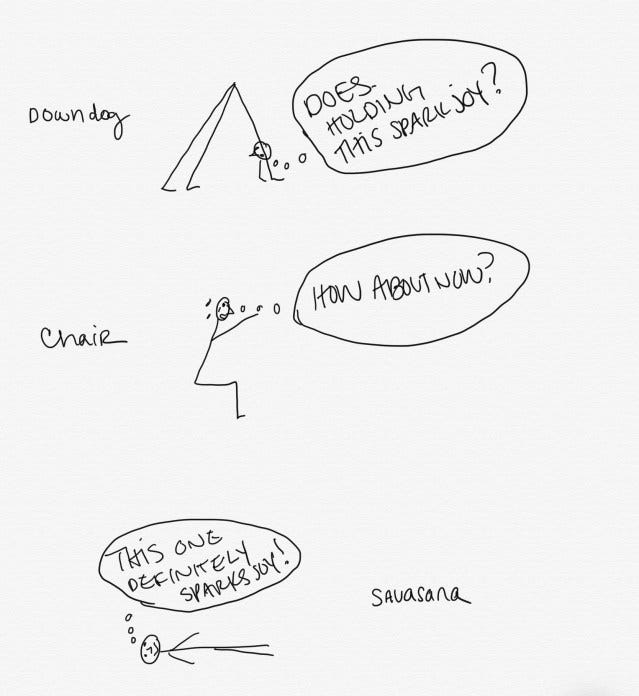The Niyamas + Minimalism
An exploration of minimalism through the second limb of yoga

For the past five or so years, I have been the community leader for the St. Louis Minimalists group. In that time, the topic of minimalism has been a growing interest in pop-culture; especially after Netflix dropped the Minimalism documentary and released the Marie Kondo reality show.
How exactly does one Mari Kondo their Downward Dog?
The ideas of minimalism are not inherently new; most of the ideology can be traced back to eastern philosophies and practices such as zen, buddhism, and yoga. While my interest in both minimalism and eastern philosophy has been around for awhile, I didn’t really look at them as interconnected.
That is, until I went through Yoga Teacher Training and got deeper into yogic philosophy. That was the first time I was really seeing and feeling these two practices side-by-side, and I wanted to start investigating immediately how we could explore these ideas through our bodies.

The Niyamas
Yoga is so much more than just making shapes with our bodies, but our bodies can be a great source of information for many layers of our wellbeing. Chair Pose may or may not immediately “spark joy” in you. There may be other benefits you find in practicing a certain shape; perhaps it sparks a feeling of strength, balance, or expansiveness? Perhaps it doesn’t serve a purpose and you practice the art of letting go. On the yoga mat (or chair), as in life, you are empowered to choose what to keep and what to release. Thoughts, feelings, clutter, people, “someday” outfits…
When we practice yoga with the intention to connect to ourselves more fully, peeling back the layers behind the postures, we may find ourselves exploring the niyamas. The niyamas are the second limb of yoga and are typically translated as ‘observances’.
Below are some examples of how the Niyamas show up in the journey of minimalism. Most of these points are taken from personal experience, as well as sharing in, and observing some incredible people on their journeys through the St. Louis Minimalists Group.
Declutter your stuff
Shaucha || Self-Purification
A lot of us start here, with physical stuff, finances, or time commitments. Maybe a life event happened and we want to feel fresh and clean. So, you begin by cleaning out the cobwebs, and letting go of what you no longer need. Many times the unloading comes with a new found sense of freedom, cleanliness, and lightness of being.
Connect with your gratitude
Santosha || Contentment
Once all of the “stuff” starts clearing out, you can focus on what you do have. Celebrating it, and taking better care of it. The closet is clean, and now you only wear your absolute favorite outfits, or your kitchen is clean, and you have space to see and cherish the tools and dishes you have (or in my case, an abundance of spices organized in mason jars). Maybe you cleaned out your basement and now have space to enjoy playing an instrument or learning a new skill.
Commit to your practices and boundaries
Tapas || Self-Discipline
Now that you are feeling lighter and grateful for all the wonderful blessings you have, you want to keep it that way. Maybe you start practicing the “one in, one out” rule with things, or setting up systems to encourage mindful spending of your time, money, and energy. Then, you communicate it well with your loved ones, who may or may not be on-board, and overtime come to respect it maybe they are even inspired to try it? Sometimes you stray from the path, and then maybe revisit your systems because you are empowered to choose what to keep and what to release. READ: not everyone is meant to live out of a backpack for the rest of their lives and live in a tiny house, which brings us to the next point…
Sit with the question: what ‘sparks joy’ for you? What are you making space for?
Svadyaya || Self-Study
The intention of minimalism is to be a conscious participant in our lives. To mindfully make decisions that are in alignment with our own needs. We all have different needs and desires. In minimalism, and in yoga, part of the practice is to continue to walk the line between ease and discomfort, working towards a balance of growth and bliss. A friend reminded me today (Thanks Christen!) that this will likely never be a perfectly straight line, but an ebb and flow between the two. It is up to us to do the work to explore what that line will look like for us individually.
Your highest calling to minimalism
Ishvara Pranidhana || Self-Surrender
What keeps you on your path? Was it to make more time for loved ones? To travel more often? To have a smaller eco-footprint? Because it just feels better? Whatever your reason is for being on this journey, remember. There will be times that it is hard, times that you may question why you are on this path, and times you may fall off of it completely. Surrender to yourself, your highest cause, and know that you can always come back to it. It’s always here for you. Be gentle with the process; we are all learning.
While yoga is so much more than just making shapes with our bodies, our bodies can be a great source of information for many layers of our wellbeing. Chair Pose may or may not immediately “spark joy” in you. There may be other benefits you find in practicing a certain shape; perhaps it sparks a feeling of strength, balance, or expansiveness? Perhaps it doesn’t serve a purpose and you practice the art of letting go. On the yoga mat (or chair), as in life, you are empowered to choose what to keep and what to release. Thoughts, feelings, clutter, people, “someday” outfits…